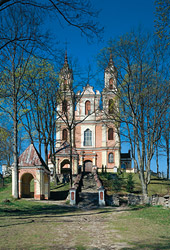Church of the Invention of the Holy Cross
Built high up on a hill, the baroque-style Church of the Invention of the Holy Cross is the centre of the Vilnius Calvary ensemble both physically and conceptually. The hill itself on which the sanctuary stands is quite similar to Mount Golgotha. The three stations (numbers 31 to 33) recalling Christ’s crucifixion, death and removal from the Cross, form part of the church building. Stations number 31 and 33 are on the outside walls near the transept, while station 32, “the Crucifixion”, is the main altar itself inside the church.
Architecturally, the church is a vaulted basilica of Latin-cross shape. Two towers, which narrow at the top, embellish the façade. Looking up from the base of the stairs, the vertical lines of the church’s architecture stand out, giving the edifice a particularly solemn appearance.
The Altar of the Crucifixion, which is the main altar, is the religious nucleus of the church’s whole interior. It is also, at the same time, the most important station on the Way of the Cross, commemorating the Saviour’s death on the Cross. The first level of the altarpiece contains a 17th century Crucifix that is famed for special graces. Among the columns on either side stand four statues, which represent the persons who took part in the removal from the Cross and burial of Jesus Christ’s body: the Blessed Virgin Mary, St John, St Nicodemus and St Joseph of Arimathea. A painting of St Helen holding the Cross adorns the smaller, simpler upper level of the altar scene.
People have long considered the Crucifixion sculpture over the main altar to be miraculous. Many extraordinary graces have been associated with it. During the major fire in the church in 1675, the figure of the Crucified Christ is said to have turned black from the smoke but to have miraculously avoided being consumed by the flames. Some 60 votive offerings are reported to have hung beside the image in the second half of the 18th century. The Dominicans encouraged devotion to Christ Crucified by distributing pictures with graphic representations of this image.
Remarkable frescos from the end of the 18th century embellish the vaults and walls of the central nave. They are thought to be the work of the Dominican painter Kristupas Polubinskis. The frescos portray the Holy Cross’s rediscovery and exaltation, as well as New Testament scenes and others which reflect devotion to the Most Sacred Heart of Jesus. No other wall paintings in Lithuania deal with the story of St Helen and the Holy Cross.








